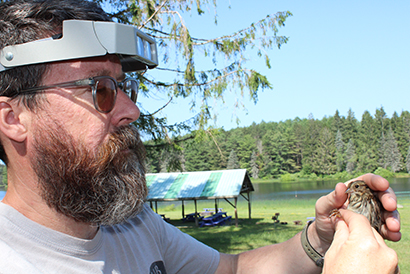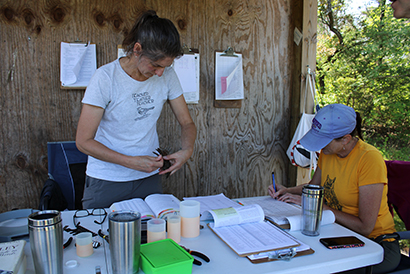Alfred University’s Foster Lake environment supports a bird banding project with continental implications.

A 2019 article in Science reported the North American continent has lost approximately 3 billion birds since 1970, a 30 percent decline in bird population. Those numbers are of particular concern to Alfred University Professor of Environmental Science Fred Beaudry and Environmental Studies Technician Nicole Munkwitz.
For years, the couple has been conducting research in Alfred relating to bird populations, originally on Pine Hill and for the last six years at Alfred University’s Foster Lake.
Beaudry teaches an ornithology class in the Division of Environmental Studies and Geology, which includes bird banding, and during the summer months, he and Munkwitz oversee bird banding in connection with the Institute for Bird Populations and its Monitoring Avian Productivity and Survivorship (MAPS) program.
“The data allows us to track bird demography,” Beaudry explains. “We can use the data to assess how well birds are reproducing and surviving.”
There are currently about 1,200 MAPS stations around the U.S., including the Foster Lake operation, which has its own proper name: The Nancy and Frederick Emerson Bird Banding Station. A 1957 graduate of Alfred University, Emerson and his wife funded the development of the station, where nets are deployed along a network of trails in the woods. Volunteers help Beaudry and Munkwitz free birds that have flown into the nets; the birds are weighed, banded, and released; the data is recorded and relayed to the national MAPS project.
Emerson Bird Banding Station. A 1957 graduate of Alfred University, Emerson and his wife funded the development of the station, where nets are deployed along a network of trails in the woods. Volunteers help Beaudry and Munkwitz free birds that have flown into the nets; the birds are weighed, banded, and released; the data is recorded and relayed to the national MAPS project.
“Given declining bird populations, we need to know where the problems are,” Beaudry says. Part of that answer is tied to the loss of breeding habitat, the result of human economic behavior tied to deforestation, agriculture, and mining. “Another problem is likely a declining insect population,” Beaudry said. “Birds eat insects, and vast amounts of insecticide are sprayed in fields to get rid of bugs.”
Beaudry and Munkwitz’s research focuses on year-round bird populations and migratory bird populations. Western New York occupies a thoroughfare for eastern migratory birds, who winter from the southern U.S. States to South America, then migrate north for nesting.
Beaudry notes healthy bird populations serve an ecological function: they perform a pest control function by eating bugs; they also are food for other animals. They also play a larger role in humans’ quality of life. “The presence of birds enriches our lives,” Beaudry says. “Physiological stress tends to decline with birdsong in the background.”
Beaudry and Munkwitz met in southern New Mexico during a bird research expedition. They moved to Alfred in 2010 and established the bird banding operation on Pine Hill.
In the summer, the work begins early, between 5:30 and 6 a.m., when the birds are busiest. They fly into the nets, which have been hung between trees in the woods. Beaudry, Munkwitz, and friends visit the nets every half hour, free the birds, and bring them to the station, restrained in individual sacks, for assessment.
“It’s a lot of work, the woods can be muddy, and we start when it’s still dark,” Beaudry says. “With friends joining in though, that leads to everyone having a little fun.”
He adds, “The students enjoy it too. It’s an educational experience that’s a little off their usual beaten paths.”
